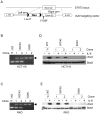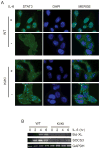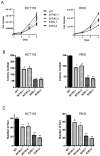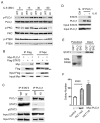Cross-talk between phospho-STAT3 and PLCγ1 plays a critical role in colorectal tumorigenesis
- PMID: 21840932
- PMCID: PMC3196678
- DOI: 10.1158/1541-7786.MCR-11-0147
Cross-talk between phospho-STAT3 and PLCγ1 plays a critical role in colorectal tumorigenesis
Abstract
Hyperphosphorylation at the Y705 residue of signal transducer and activator of transcription 3 (STAT3) is implicated in tumorigenesis of leukemia and some solid tumors. However, its role in the development of colorectal cancer is not well defined. To rigorously test the impact of this phosphorylation on colorectal tumorigenesis, we engineered a STAT3 Y705F knock-in to interrupt STAT3 activity in HCT116 and RKO colorectal cancer cells. These STAT3 Y705F mutant cells fail to respond to cytokine stimulation and grow slower than parental cells. These mutant cells are also greatly diminished in their abilities to form colonies in culture, to exhibit anchorage-independent growth in soft agar, and to grow as xenografts in nude mice. These observations strongly support the premise that STAT3 Y705 phosphorylation is crucial in colorectal tumorigenesis. Although it is generally believed that STAT3 functions as a transcription factor, recent studies indicate that transcription-independent functions of STAT3 also play an important role in tumorigenesis. We show here that wild-type STAT3, but not STAT3 Y705F mutant protein, associates with phospholipase Cγ1 (PLCγ1). PLCγ1 is a central signal transducer of growth factor and cytokine signaling pathways that are involved in tumorigenesis. In STAT3 Y705F mutant colorectal cancer cells, PLCγ1 activity is reduced. Moreover, overexpression of a constitutively active form of PLCγ1 rescues the transformation defect of STAT3 Y705F mutant cells. In aggregate, our study identifies previously unknown cross-talk between STAT3 and the PLCγ signaling pathways that may play a critical role in colorectal tumorigenesis.
Figures





Similar articles
-
Activation of signal transducer and activator of transcription 3 through a phosphomimetic serine 727 promotes prostate tumorigenesis independent of tyrosine 705 phosphorylation.Cancer Res. 2008 Oct 1;68(19):7736-41. doi: 10.1158/0008-5472.CAN-08-1125. Cancer Res. 2008. PMID: 18829527 Free PMC article.
-
A microRNA 221- and 222-mediated feedback loop maintains constitutive activation of NFκB and STAT3 in colorectal cancer cells.Gastroenterology. 2014 Oct;147(4):847-859.e11. doi: 10.1053/j.gastro.2014.06.006. Epub 2014 Jun 12. Gastroenterology. 2014. PMID: 24931456 Free PMC article.
-
Loss of phospholipase Cγ1 suppresses hepatocellular carcinogenesis through blockade of STAT3-mediated cancer development.Hepatol Commun. 2022 Nov;6(11):3234-3246. doi: 10.1002/hep4.2077. Epub 2022 Sep 25. Hepatol Commun. 2022. PMID: 36153805 Free PMC article.
-
Activation of JAK2/STAT3 signaling by osteopontin promotes tumor growth in human breast cancer cells.Carcinogenesis. 2010 Feb;31(2):192-200. doi: 10.1093/carcin/bgp289. Epub 2009 Nov 19. Carcinogenesis. 2010. PMID: 19926637
-
microRNA-375 inhibits colorectal cancer cells proliferation by downregulating JAK2/STAT3 and MAP3K8/ERK signaling pathways.Oncotarget. 2017 Mar 7;8(10):16633-16641. doi: 10.18632/oncotarget.15114. Oncotarget. 2017. PMID: 28186962 Free PMC article.
Cited by
-
Gain of interaction with IRS1 by p110α-helical domain mutants is crucial for their oncogenic functions.Cancer Cell. 2013 May 13;23(5):583-93. doi: 10.1016/j.ccr.2013.03.021. Epub 2013 May 2. Cancer Cell. 2013. PMID: 23643389 Free PMC article.
-
Emerging Role of Plant-Based Dietary Components in Post-Translational Modifications Associated with Colorectal Cancer.Life (Basel). 2023 Jan 18;13(2):264. doi: 10.3390/life13020264. Life (Basel). 2023. PMID: 36836621 Free PMC article. Review.
-
Ube2g2-gp78-mediated HERP polyubiquitylation is involved in ER stress recovery.J Cell Sci. 2014 Apr 1;127(Pt 7):1417-27. doi: 10.1242/jcs.135293. Epub 2014 Feb 4. J Cell Sci. 2014. PMID: 24496447 Free PMC article.
-
LPA Induces Colon Cancer Cell Proliferation through a Cooperation between the ROCK and STAT-3 Pathways.PLoS One. 2015 Sep 29;10(9):e0139094. doi: 10.1371/journal.pone.0139094. eCollection 2015. PLoS One. 2015. PMID: 26418031 Free PMC article.
-
A one-step cloning method for the construction of somatic cell gene targeting vectors: application to production of human knockout cell lines.BMC Biotechnol. 2012 Oct 9;12:71. doi: 10.1186/1472-6750-12-71. BMC Biotechnol. 2012. PMID: 23046873 Free PMC article.
References
Publication types
MeSH terms
Substances
Grants and funding
LinkOut - more resources
Full Text Sources
Medical
Molecular Biology Databases
Miscellaneous

